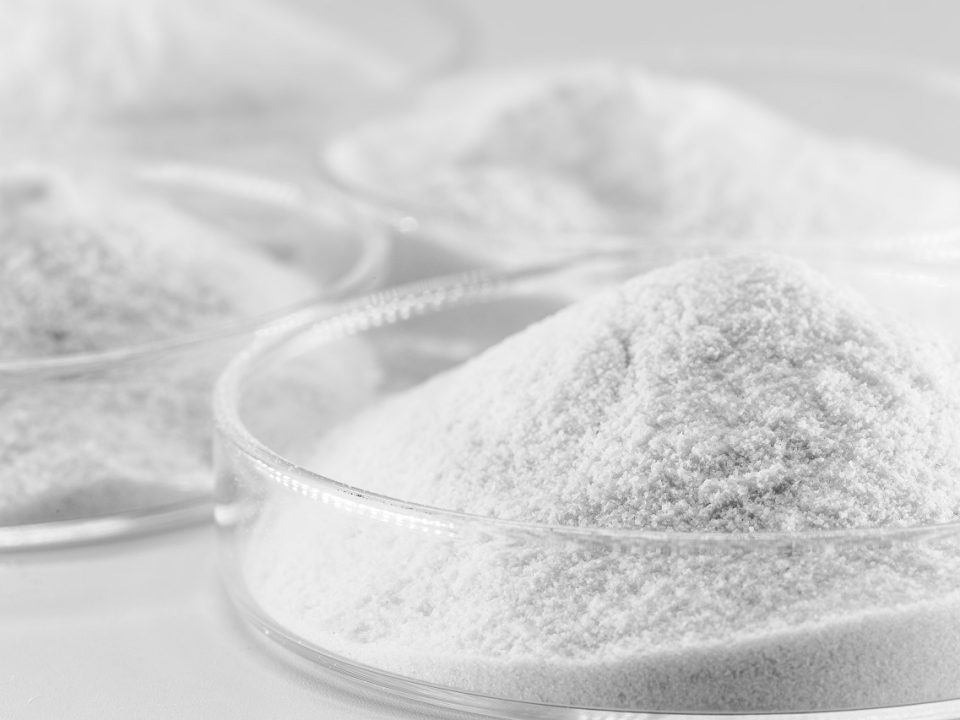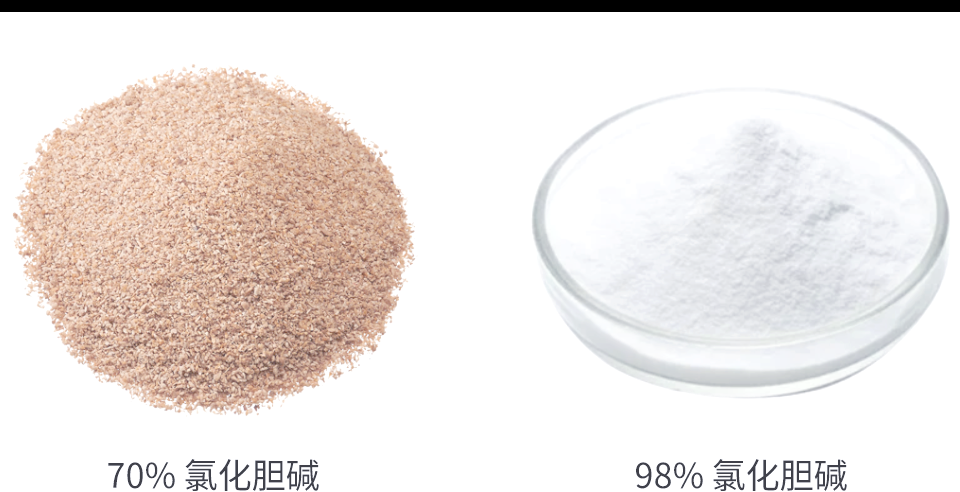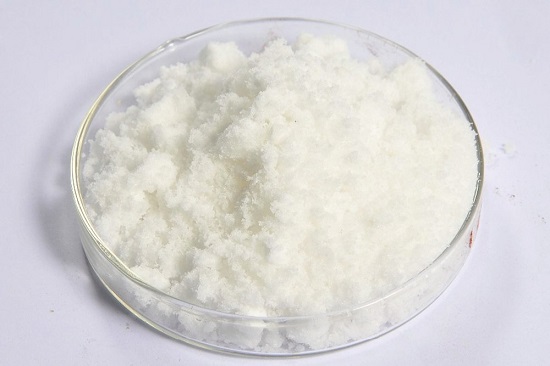مسحوق كلوريد الكولين كمضاف تغذية للحيوانات

شهادة التحليل لمسحوق عظم الدجاج
مايو 13, 2025
وجبة الدجاج لطعام الكلاب, لماذا تستخدم وجبة الدجاج في طعام الكلاب
حزيران/يونيه 13, 2025تحليل شامل لمسحوق كلوريد الكولين كمضاف تغذية للحيوانات
المقدمة
مسحوق كلوريد الكولين, ملحق غذائي حرج في تغذية الحيوانات, يعترف على نطاق واسع بدوره في دعم صحة وإنتاجية الأنواع الحيوانية المختلفة, بما في ذلك الدواجن, الخنازير, المجترات, أنواع الاستزراع المائي, والحيوانات المصاحبة. مصنفة على أنها فيتامين B-commlex (غالبًا ما يطلق عليه فيتامين ب 4), كلوريد الكولين هو ملح الأمونيوم الرباعي ضروري للعديد من الوظائف الفسيولوجية, مثل التمثيل الغذائي للدهون, تخليق غشاء الخلية, وإنتاج الناقل العصبي. تنبع أهميتها من حقيقة أن العديد من الحيوانات, لا سيما الصغار, لا يمكن تجميع كميات كافية من الكولين داخليًا, استلزم مكملات غذائية لمنع أوجه القصور التي يمكن أن تضعف النمو, الاستنساخ, والصحة العامة.
في التغذية الحيوانية, كلوريد الكولين يتم تقديره لقدرته على منع حالات مثل متلازمة الكبد الدهنية, تعزيز معدلات النمو, وتحسين كفاءة تحويل الأعلاف. شكل مسحوق, عادة ما يتم امتصاصها على شركات النقل مثل خبز الذرة, قشر الأرز, أو السيليكا, يفضل لسهولة دمجها في تركيبات الأعلاف والاستقرار أثناء التخزين. متوفر بتركيزات تتراوح من 50% إلى 98%, تلبي احتياجات متنوعة عبر الصناعات الثروة الحيوانية وتربية الأحياء المائية. يستكشف هذا القسم الدور متعدد الأوجه لكلوريد الكولين, الخوض في أهميتها الكيميائية الحيوية, تطبيقات الصناعة, والأساس المنطقي لاستخدامه على نطاق واسع.
الدور الكيميائي الحيوي لكلوريد الكولين متجذر في مساهمته في تخليق الفسفوليبيد, وخاصة الفوسفاتيديل كولين, وهو مكون رئيسي في أغشية الخلايا. كما أنه بمثابة مقدمة لأسيتيل كولين, الناقل العصبي حاسم لوظيفة الأعصاب, ويعمل كمتبرع مجموعة الميثيل, دعم عمليات التمثيل الغذائي مثل تخليق الميثيونين. في الدواجن, على سبيل المثال, مكملات الكولين تمنع الرضا (وتر تراجع) ويعزز إنتاج البيض, بينما في الخنازير, يحسن حجم القمامة وبقاء الخنزير. للمجترات, يخفف من الكبد الدهني أثناء الرضاعة المبكرة, وفي تربية الأحياء المائية, إنه يعزز النمو والحصانة.
ارتفع الطلب العالمي على كلوريد الكولين بسبب الممارسات الزراعية المكثفة والحاجة إلى أداء حيوان محسّن. يمتد تنوعه إلى الحيوانات المصاحبة, حيث يدعم صحة الكبد والوظيفة المعرفية. ومع ذلك, تحديات مثل طبيعتها الثابتة وإمكانية تريميثيلامين (الجمعية التونسية للأمهات) يتطلب التكوين معالجة وصياغة دقيقة لزيادة الفعالية. يهدف هذا التقرير إلى توفير تحليل شامل لمسحوق كلوريد الكولين, تغطي مواصفاته, التركيبة الكيميائية, خصائص المواد, تطبيقات, الجرعة, سلامة, وتقييم علمي مقارن, ضمان فهم شامل لدورها في تغذية الحيوانات.
يتضمن إنتاج كلوريد الكولين رد فعل حمض الهيدروكلوريك مع تريميثيل أمين وأكسيد الإيثيلين, مما أدى إلى منتج صناعي فعال من حيث التكلفة. بينما توفر المصادر الطبيعية مثل وجبة فول الصويا الكولين, محتوىهم المتغير يجعل المكملات مع كلوريد الكولين الاصطناعية ضرورية للتغذية المتسقة. استقرار مسحوق النموذج وسهولة الاستخدام يجعله عنصرًا أساسيًا في مصانع الأعلاف, لكن حدودها, مثل التآكل وتدهور الفيتامينات في الممتلكات, يستلزم الإدارة الدقيقة. هذه المقدمة تحدد المرحلة لاستكشاف تفصيلي لمواصفات كلوريد الكولين وتطبيقاتها, تسليط الضوء على دورها الذي لا غنى عنه في تربية الحيوانات الحديثة.
مواصفات
مسحوق كلوريد الكولين غرامة, إضافة الأعلاف الحبيبية المصممة لسهولة الاندماج في الوجبات الحيوانية, تقديم مجموعة من التركيزات والخصائص الفيزيائية مصممة لتطبيقات محددة. تشمل مواصفاته الشكل المادي, تركيز, التعبئة والتغليف, متطلبات التخزين, ومعايير الجودة, ضمان ملاءمة احتياجات التغذية الحيوانية المتنوعة. يوفر هذا القسم نظرة متعمقة على هذه المواصفات, التأكيد على أهميتها في الحفاظ على فعالية المنتج وسلامته.
الشكل المادي والمظهر
يتميز شكل مسحوق كلوريد الكولين بمظهره المصفر أو البني أو المظهر, غالبًا ما تتأثر بالمواد الحاملة المستخدمة, مثل كوز الذرة, السيليكا, أو مسحوق قشر الأرز. يضمن الملمس الحبيبي بشكل جيد خلط موحد في التغذية, بينما رائحتها السمكية الطفيفة, يعزى إلى تتبع كميات من تريميثيل أمين (الجمعية التونسية للأمهات), هي خاصية طبيعية. تتطلب الطبيعة الرطبة لكلوريد الكولين التعامل الدقيق لمنع امتصاص الرطوبة, والتي يمكن أن تؤدي إلى تكتل وتقليل مدة الصلاحية.
تركيز
مسحوق كلوريد الكولين متوفر بتركيزات تتراوح من 50% إلى 98%, مع كل أغراض محددة:
-
50%: شائع الاستخدام في تغذية الدواجن والخنازير, تم امتصاصه على خبز الذرة من أجل فعالية التكلفة.
-
60%: خيار متعدد الاستخدامات للماشية وتربية الأحياء المائية, موازنة الفعالية والقدرة على تحمل التكاليف.
-
70%: يفضل في الأماكن الممتدة للخنازير وأملة الألبان, تقديم فاعلية أعلى.
-
98%: شكل عالي النقاء يستخدم في التطبيقات المتخصصة, بما في ذلك المكملات البشرية وتغذية الحيوانات الأليفة.
يشير التركيز إلى محتوى كلوريد الكولين, مع تقريبا 25% من الوزن الجزيئي المنسوبة إلى كلوريد, بمعنى أ 60% المنتج يحتوي على 45% الكولين النقي. هذا التمييز أمر بالغ الأهمية للجرعات الدقيقة في تركيبات الأعلاف.
التعبئة والتغليف والتخزين
عادة ما يتم تعبئة مسحوق كلوريد الكولين في 25 أكياس KG متعددة الطبقات مع بطانة مقاومة للماء للحماية من الرطوبة. بعض الشركات المصنعة تقدم 1 أكياس كيلوغرام أو خيارات كبيرة للعمليات واسعة النطاق. شروط التخزين صارمة بسبب رطوبة المنتج, يتطلب باردا, الجافة, بيئة جيدة التهوية. الحاويات المختومة ضرورية للحفاظ على الاستقرار, مع مدة صلاحية نموذجية 24 أشهر عندما يتم تخزينها بشكل صحيح. يمكن أن يؤدي التعرض للحرارة أو الرطوبة إلى تسريع تكوين TMA ويؤدي إلى تدهور جودة المنتج.
معايير الجودة
يلتزم الشركات المصنعة بمكافآت جودة صارمة لتقليل الشوائب:
-
trimethylamine (الجمعية التونسية للأمهات): يقتصر على -300 جزء في المليون لمنع مشاكل الرائحة والسمية المحتملة.
-
الفلزات الثقيلة (الجريدة الرسمية): يقتصر على -10 جزء في المليون لضمان سلامة الحيوانات والمستهلكين.
-
الخسارة في تجفيف: ≤2 ٪ للحفاظ على استقرار المنتج ومنع كوك.
تتماشى هذه المعايير مع المتطلبات التنظيمية في مناطق مثل الاتحاد الأوروبي والولايات المتحدة الأمريكية, ضمان الاستخدام الآمن في تغذية الحيوانات. اختيار الناقل (على سبيل المثال, كوز الذرة مقابل. السيليكا) يؤثر على قابلية تدفق المنتج واستقراره, مع المنتجات القائمة على السيليكا التي تقدم أداءً فائقًا في الظروف الرطبة ولكن بتكلفة أعلى.
اعتبارات عملية
تؤثر مواصفات مسحوق كلوريد الكولين بشكل مباشر على تطبيقه في مصانع الأعلاف. على سبيل المثال, ال 60% يستخدم التركيز على نطاق واسع بسبب توازن التكلفة والفعالية, بينما 98% النموذج محجوز للتطبيقات عالية الدقة. تستلزم طبيعة المسحوق الرطبة صياغة دقيقة لتجنب التفاعلات مع مكونات التغذية الأخرى, مثل الفيتامينات, التي قد تتحلل في وجودها. يؤكد هذا القسم على أهمية فهم مواصفات كلوريد الكولين لتحسين استخدامه في تغذية الحيوانات, وضع الأساس للمناقشات اللاحقة حول خصائصها الكيميائية والمادية.
التركيبة الكيميائية
التركيب الكيميائي لمسحوق كلوريد الكولين هو حجر الزاوية في وظائفه كضافحة التغذية, التأثير على أدوارها البيولوجية واستقرارها في تركيبات الأعلاف. كلوريد الكولين, يُعرف كيميائيًا باسم كلوريد الأمونيوم-هيدروكسي إيثيل ثنائي ميثيل, هو ملح أمونيوم رباعي مع الصيغة الجزيئية c₅hclno ووزن جزيئي من 139.62 g/mol. هذا القسم يتعمق في تكوينه, الشوائب, وآثارها على تغذية الحيوانات.
تكوين عنصري
الانهيار العنصري التقريبي لكلوريد الكولين النقي كما يلي:
|
عنصر |
نسبة مئوية |
|---|---|
|
الكربون (C) |
34.5% |
|
هيدروجين (H) |
8.0% |
|
النيتروجين (ن) |
10.0% |
|
الأكسجين (ال) |
11.5% |
|
الكلور (Cl) |
25.5% |
في أشكال المسحوق التجاري (على سبيل المثال, 50% أو 60% تركيز), يتكون الوزن المتبقي من شركات النقل مثل خبز الذرة أو السيليكا, الذي يستقر على المنتج ويسهل التعامل. هذه الناقلات خاملة ولا تسهم في القيمة الغذائية ولكنها تؤثر على الخصائص الفيزيائية للمنتج, مثل قابلية التدفق والرطوبة.
الذوبان والتفاعلية
كلوريد الكولين قابل للذوبان للغاية في الماء, مما يجعلها بسهولة متاحة للحيوانات في أنظمة الجهاز الهضمي. إنه قابل للذوبان بعض الشيء في الإيثانول ولكنه غير قابل للذوبان في المذيبات المحايدة, الذي يؤثر على دمجه في التغذية. تتضمن تفاعلها تكوين المذيبات العميقة مع مركبات مثل اليوريا أو الجلسرين, عقار مستغل في بعض التطبيقات الصناعية ولكنه أقل أهمية في الأعلاف. ومع ذلك, يمكن أن تؤدي طبيعتها الرطبة إلى تفاعلات مع مكونات التغذية الأخرى, فيتامينات خاصة, تسبب في تدهور إذا لم تتم إدارته بشكل صحيح.
الشوائب
يعد مراقبة الجودة أمرًا بالغ الأهمية لتقليل الشوائب التي يمكن أن تؤثر على صحة الحيوان أو جودة المنتج:
-
trimethylamine (الجمعية التونسية للأمهات): نتيجة ثانوية لتوليف كلوريد الكولين, يقتصر TMA على -300 جزء في المليون لتجنب الروائح المريب في المنتجات الحيوانية مثل البيض أو لحم الخنزير. يمكن أن يقلل TMA المفرط أيضًا من التوافر البيولوجي.
-
الفلزات الثقيلة: تقتصر الرصاص والمعادن الثقيلة الأخرى على -10 جزء في المليون لضمان السلامة.
-
محتوى الرطوبة: يتم الاحتفاظ بخسارة التجفيف بنسبة ≤2 ٪ لمنع الكرب والحفاظ على الاستقرار.
الآثار البيولوجية
التكوين الكيميائي يدعم دور كلوريد الكولين في استقلاب الحيوانات. مكونات النيتروجين والكربون جزء لا يتجزأ من وظيفتها كسلائف للفوسفاتيديل كولين وأسيتيل كولين. يضمن أيون كلوريد القابلية للذوبان والاستقرار, في حين أن المواد الحاملة في منتجات التركيز المنخفضة تقلل من التكاليف ولكنها قد تخفف من الفعالية. وجود TMA, حتى في المستويات المنخفضة, يتطلب مراقبة دقيقة, حيث يمكن للميكروبات الأمعاء أن تتحول إلى 66% من الكولين الغذائي في TMA, تقليل التوافر البيولوجي وربما تسبب مشاكل الرائحة.
التحليل المقارن
بالمقارنة مع مصادر الكولين الطبيعية (على سبيل المثال, فول الصويا), يوفر كلوريد الكولين الاصطناعي تكوينًا ثابتًا ولكن التوافر البيولوجي المنخفض بسبب تحويل TMA. الأشكال الطبيعية, مثل الفوسفاتيديل كولين, أكثر توفرًا للبيولوجي ولكنها أكثر تكلفة. يؤثر اختيار الناقل أيضًا على الأداء, مع المنتجات القائمة على السيليكا التي توفر استقرارًا أفضل في الظروف الرطبة مقارنة بالمنزلات القائمة على كوز الذرة. يسلط هذا القسم الضوء على أهمية التركيب الكيميائي في تحديد فعالية كلوريد الكولين وسلامته, تمهد الطريق لمناقشة خصائصها المادية.
خصائص المواد
خصائص المواد من مسحوق كلوريد الكولين, تشمل المادية, كيميائية, والخصائص البيولوجية, من الأهمية بمكان لأدائها بمثابة مضافة للتغذية. هذه الخصائص تؤثر على معالجتها, الاستقرار, والفعالية في التغذية الحيوانية, جعلها نقطة محورية لمصنعي الأعلاف والمزارعين. يستكشف هذا القسم هذه الخصائص بالتفصيل, تقديم نظرة ثاقبة لآثارها العملية.
الخصائص الفيزيائية
مسحوق كلوريد الكولين غرامة, مواد حبيبية ذات مظهر بني مصفر أو بني, اعتمادا على الناقل (على سبيل المثال, كوب الذرة, السيليكا). رائحة مريب طفيفة, بسبب بقايا TMA, هي ميزة مميزة. تشكل رطوبة المسحوق تحديًا كبيرًا, لأنه يمتص الرطوبة بسهولة, مما يؤدي إلى التكتل والتدهور المحتمل لمكونات التغذية الأخرى. يختلف حجم الجسيمات من الغرامة إلى الحبيبية, ضمان توزيع موحد في التغذية ولكن يتطلب تخزينًا دقيقًا للحفاظ على قابلية التدفق.
خصائص المواد الكيميائية
كيميائيا, كلوريد الكولين مستقر في ظل الظروف العادية ولكنه يمكن أن يؤدي إلى تدهور الفيتامينات أ, د, و K في الأمراض المسبقة بسبب طبيعتها الرطبة والتآكل قليلاً. يتفاقم هذا التحلل في وجود عناصر معدنية, استلزم صياغة دقيقة. يعزز قابلية ذوبان المياه العالية التوافر البيولوجي ولكنه يساهم أيضًا في رطوبةها, تتطلب تخزين مختومة. تفاعل كلوريد الكولين مع مركبات مثل اليوريا أو الجلسرين أقل أهمية في التغذية ولكنه يسلط الضوء على تعدد استخداماتها الكيميائية.
الخصائص البيولوجية
بيولوجيا, كلوريد الكولين مغذيات حاسمة:
-
استقلاب الدهون: يمنع متلازمة الكبد الدهنية عن طريق تعزيز تخليق الفسفوليبيد, وخاصة الفوسفاتيديل كولين, الذي يسهل نقل الدهون.
-
تخليق الناقل العصبي: بمثابة مقدمة لأسيتيل كولين, دعم وظيفة الأعصاب والتنسيق.
-
سلامة غشاء الخلية: يساهم في الفوسفاتيديل كولين, مكون رئيسي من أغشية الخلايا.
-
التبرع مجموعة الميثيل: يعمل كمتبرع ميثيل, تجنيب الميثيونين ودعم عمليات التمثيل الغذائي.
هذه الخصائص تجعل كلوريد الكولين لا غنى عنه للحيوانات الصغيرة وتلك تحت الإجهاد الأيضي العالي, مثل الأبقار المرضعة أو اللاحم المتنمو بسرعة.
الآثار العملية
تتطلب الطبيعة الرطبة لكلوريد الكولين تخزينًا جافًا وصياغة دقيقة لمنع التفاعلات مع مكونات التغذية الأخرى. تآكلها, خاصة في الأشكال السائلة, يمكن أن تلحق الضرر, يستلزم الفولاذ المقاوم للصدأ أو الآلات المطلية. تضمن الخصائص البيولوجية فعاليتها عبر الأنواع, لكن احتمال تكوين TMA يقلل من التوافر البيولوجي, تتطلب جرعات دقيقة لتجنب النفايات. تعمل شركات النقل القائمة على السيليكا على تحسين الاستقرار مقارنةً بغطاء الذرة, لكن تكلفةها المرتفعة قد تحد من الاستخدام في العمليات الواعية للميزانية.
التحليل المقارن
بالمقارنة مع كلوريد الكولين السائل, نموذج المسحوق أسهل في التعامل معه وتخزينه ولكنه أقل مرونة في بعض التطبيقات, مثل مكملات مياه الشرب. مصادر الكولين الطبيعية, مثل وجبة فول الصويا, تقديم محتوى الكولين المتغير, جعل كلوريد الكولين الاصطناعية خيارًا أكثر موثوقية للتغذية المتسقة. يؤكد هذا القسم على أهمية فهم خصائص مواد كلوريد الكولين لتحسين استخدامه في التغذية, وضع المسرح لتطبيقاتها في تغذية الحيوانات.
التطبيقات في التغذية الحيوانية
مسحوق كلوريد الكولين هو مضافة للتغذية متعددة الاستخدامات مع تطبيقات عبر الدواجن, الخنازير, المجترات, تربية الأحياء المائية, والحيوانات المصاحبة. دورها في دعم النمو, صحة, والإنتاجية تجعلها حجر الزاوية في التغذية الحيوانية الحديثة. يستكشف هذا القسم تطبيقاته, تسليط الضوء على الفوائد الخاصة بالأنواع وأعراض النقص.
تربية الدواجن
في الدواجن, كلوريد الكولين يعزز النمو, كفاءة التغذية, وإنتاج البيض. للانتقام, المكملات في 600-1200 جم/طن من التغذية تحسن زيادة الوزن وتمنع اليرق ومتلازمة الكبد الدهنية. في الطبقات, وهو يدعم إنتاج البيض, جودة قشر البيض, وتكوين صفار, مع المآخذ الموصى بها من 105 ملغ/يوم لطبقات البيض الأبيض و 115 ملغ/يوم لطبقات البيض البني. تشمل أعراض النقص انخفاض النمو, برسيس, وسوء الفقس.
الخنازير
للخنازير, كلوريد الكولين يحسن بقاء الخنازير ويزرع الخصوبة. جرعات من 600-1300 جم/طن تدعم عملية التمثيل الغذائي للدهون والنمو في الخنازير, بينما في الأزعار, يعزز حجم القمامة والصحة الإنجابية. تشمل أعراض النقص نموًا أبطأ, الاضطرابات السلوكية, والكبد الدهني.
المجترات
في الماشية الألبان, كلوريد الكولين (500-1000 جم/طن) يمنع الكبد الدهني أثناء الرضاعة المبكرة ويعزز إنتاج الحليب. في الأبقار لحوم البقر, وهو يدعم زيادة الوزن ويقلل من ترسب الدهون. تشمل أعراض نقص القضايا التنفسية, انخفاض شهية, وأبطأ النمو.
تربية الأحياء المائية
في الأسماك والروبيان, كلوريد الكولين (800-3000 جم/طن) يعزز النمو, يحسن كفاءة التغذية, ويعزز المناعة في النظم المكثفة. تشمل أعراض نقص الكبد الدهني, نزيف الكلى, وسوء النمو.
حيوانات أليفة
في الكلاب والقطط, كلوريد الكولين يدعم صحة الكبد والوظيفة المعرفية, خاصة في حالات النوبات أو الخلل المعرفي. تشمل أعراض النقص خلل وظيفي في الكبد وتقليل الشهية.
اعتبارات عملية
تعتمد فعالية كلوريد الكولين على تكوين التغذية, كمصادر طبيعية مثل وجبة فول الصويا توفر مستويات الكولين المتغيرة. تأثيره في تجميع الميثيونين يقلل من التكاليف الغذائية, ولكن يجب تجنب الإفراط في التغذية لمنع مشاكل الرائحة المتعلقة بـ TMA. يسلط هذا القسم الضوء على قابلية تطبيق كلوريد الكولين الواسعة, التأكيد على دورها في تحسين صحة الحيوان وإنتاجيته.
توصيات الجرعة
تعتبر الجرعات المناسبة لمسحوق كلوريد الكولين أمرًا بالغ الأهمية لزيادة فوائده مع تجنب النفايات أو الآثار الضارة. تختلف الجرعة حسب الأنواع, عمر, مرحلة الإنتاج, وتكوين التغذية. يقدم هذا القسم توصيات مفصلة, بدعم من جدول واعتبارات عملية.
جدول الجرعة (60% تركيز)
|
الأنواع |
الجرعة (ز/طن من التغذية) |
ملحوظات |
|---|---|---|
|
دجاجة |
600-1200 |
جرعات أعلى للوجبات الغذائية المبتدئة; ضبط بناءً على محتوى الكولين الطبيعي. |
|
الطبقات |
500-1000 |
يدعم إنتاج البيض; 500 ز/طن كافية للصيانة. |
|
الخنازير |
600-1300 |
جرعات أعلى للخنازير والزعف لدعم النمو والتكاثر. |
|
ماشية الألبان |
500-1000 |
يمنع الكبد الدهني أثناء الرضاعة المبكرة. |
|
الأسماك |
800-2000 |
جرعات أعلى للأنظمة المكثفة لدعم النمو والحصانة. |
|
الجمبري |
1000-3000 |
يعزز النمو والبقاء في تربية الأحياء المائية عالية الكثافة. |
العوامل التي تؤثر على الجرعة
-
محتوى الكولين الطبيعي: مكونات مثل وجبة فول الصويا (2500-3000 ملغ/كغ من الكولين) تقليل احتياجات المكملات.
-
مرحلة الإنتاج: تتطلب الحيوانات المتنامية والإناث المربعات جرعات أعلى.
-
معالجة الأعلاف: قد يقلل الحبيبات أو البثق من التوافر البيولوجي الكولين, استلزم ارتفاع معدلات التضمين.
اعتبارات عملية
الإفراط في تكاليف (>2000 ملغ/كغ في الدواجن) لا يوفر أي فوائد إضافية وقد يزيد من إنتاج TMA, يؤدي إلى قضايا الرائحة. يسمح تأثير تجويف الميثيونين بانخفاض إدراج الميثيونين, خفض تكاليف العلف. هناك حاجة إلى صياغة دقيقة لتجنب التفاعلات مع الفيتامينات, وقد تعمل شركات النقل القائمة على السيليكا على تحسين الاستقرار في بيئات الرطوبة العالية. يوفر هذا القسم دليلًا شاملاً للجرعات, ضمان الاستخدام الأمثل لكلوريد الكولين في تغذية الحيوانات.
السلامة والتعامل
تعتبر سلامة مسحوق كلوريد الكولين والتعامل معها أمرًا بالغ الأهمية لاستخدامه الفعال في تغذية الحيوانات. يغطي هذا القسم السلامة للحيوانات, البشر, والبيئة, جنبا إلى جنب مع التعامل مع اعتبارات للحفاظ على جودة المنتج.
سلامة الحيوانات
كلوريد الكولين آمن في الجرعات الموصى بها, مع هامش أمان صغير في الدواجن والخنازير. يجب تجنب الجرعة الزائدة, خاصة عند استخدامها في كل من مياه الأعلاف والشرب. إنتاج TMA المفرط (>300 جزء في المليون) يمكن أن يسبب رائحة مريب في المنتجات الحيوانية, التأثير على التسويق. تشمل مخاطر النقص الكبد الدهني, انخفاض النمو, والقضايا الإنجابية.
السلامة للبشر
كلوريد الكولين لا يشكل أي خطر كبير على المستهلكين, كما يتم استقلابها بواسطة الحيوانات ولا تتراكم في الأنسجة. للعمال, مخاطر الاستنشاق منخفضة, كما من غير المرجح أن تصل الجسيمات. حلول مائية (حتى 70%) غير ضحيتين, لكن الأشكال الصلبة قد تسبب توعية الجلد لدى الأفراد الحساسين.
التأثير البيئي
استخدام كلوريد الكولين في التغذية له الحد الأدنى من التأثير البيئي, لأنه لا يزيد بشكل كبير من تركيزات التربة أو الماء. يوصى بالتخلص السليم من المنتج غير المستخدم لمنع التلوث الموضعي.
التعامل مع الاعتبارات
تتطلب رطوبة المسحوق تخزينًا مختومة لمنع التشكيل وتدهور الفيتامينات. تآكلها, خاصة في الأشكال السائلة, يستلزم المعدات المناسبة. يضمن مراقبة الجودة انخفاض مستويات TMA والمعادن الثقيلة, الحفاظ على السلامة والفعالية. يؤكد هذا القسم على أهمية المناولة السليمة لزيادة فوائد كلوريد الكولين مع تقليل المخاطر إلى الحد الأدنى.
التحليل العلمي والمقارنة
يوفر هذا القسم تقييمًا علميًا لفعالية كلوريد الكولين, مقارنته بمصادر الكولين البديلة وتحليل تحدياتها وفوائدها.
الفعالية في تغذية الحيوانات
يوضح البحث فعالية كلوريد الكولين:
-
تربية الدواجن: إيميرت وبيكر (1997) وجدت النمو الأمثل في اللاحم في 800 مغ/كغ, مع تحسين العلف.
-
الخنازير: جرعات من 600-1300 جم/طن تعزز بقاء الخنازير وذاتية زرع.
-
تربية الأحياء المائية: 1000-3000 جم/طن يحسن نمو الروبيان والحصانة.
الاصطناعية مقابل. الكولين الطبيعي
-
كلوريد الكولين الاصطناعي: فعالة من حيث التكلفة ولكن عرضة لتحويل TMA (حتى 66% خسارة).
-
الكولين الطبيعي (على سبيل المثال, Natu-B4™): مزيد من التوافر البيولوجي, قابلية الحرارة, وخالية من TMA ولكن أكثر تكلفة.
بدائل
-
فوسفاتيديل كولين: يوفر فاعلية أعلى والاستقرار ولكن يتطلب جرعات أقل.
-
بروبيل بتائين: يعمل كمتبرع ميثيل ولكنه يفتقر إلى دور الناقل العصبي في الكولين.
التحديات
-
الرطوبة: يسبب التكتل وتدهور الفيتامينات.
-
تشكيل TMA: يقلل من التوافر البيولوجي ويسبب مشاكل الرائحة.
-
تفاعلات فيتامين: يسرع تدهور الفيتامينات أ, د, و K..
الجدول المقارن
|
المعلمة |
كلوريد الكولين (60%) |
فوسفاتيديل كولين |
بروبيل بتائين |
|---|---|---|---|
|
يكلف |
منخفضة |
متوسط |
معتدل |
|
التوافر البيولوجي |
معتدل |
متوسط |
متوسط (مانح الميثيل فقط) |
|
الرطوبة |
متوسط |
منخفضة |
منخفضة |
|
تشكيل TMA |
متوسط |
لا أحد |
لا أحد |
يسلط هذا القسم الضوء على فعالية كلوريد الكولين وتحدياتها, توفير أساس علمي لاستخدامه ومقارنته بالبدائل.
استنتاج
مسحوق كلوريد الكولين هو مضاف حيوي تغذية, دعم صحة الحيوان والإنتاجية عبر الأنواع. دورها في التمثيل الغذائي للدهون, تخليق الناقل العصبي, والتبرع الميثيل يجعله لا غنى عنه, خاصة بالنسبة للحيوانات الصغيرة أو العالية المنتجة. في حين أن الرطوبة وتشكيل TMA يطرحون تحديات, يمكن للمعالجة والصياغة السليمة تخفيف هذه المشكلات. توفر بدائل مثل الفوسفاتيديل كولين مزايا ولكن بتكاليف أعلى. من خلال الالتزام بالجرعات الموصى بها وممارسات التخزين, يمكن للمزارعين تحسين فوائد كلوريد الكولين, ضمان التغذية الحيوانية المستدامة والفعالة.






